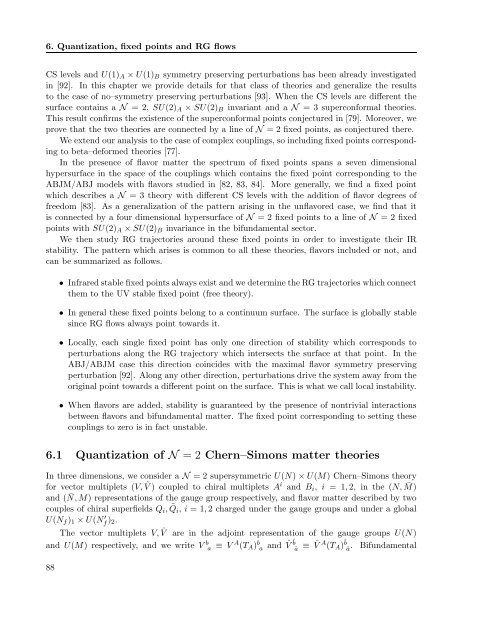Perturbative and non-perturbative infrared behavior of ...
Perturbative and non-perturbative infrared behavior of ...
Perturbative and non-perturbative infrared behavior of ...
You also want an ePaper? Increase the reach of your titles
YUMPU automatically turns print PDFs into web optimized ePapers that Google loves.
6. Quantization, fixed points <strong>and</strong> RG flows<br />
CS levels <strong>and</strong> U(1)A × U(1)B symmetry preserving perturbations has been already investigated<br />
in [92]. In this chapter we provide details for that class <strong>of</strong> theories <strong>and</strong> generalize the results<br />
to the case <strong>of</strong> no–symmetry preserving perturbations [93]. When the CS levels are different the<br />
surface contains a N = 2, SU(2)A × SU(2)B invariant <strong>and</strong> a N = 3 superconformal theories.<br />
This result confirms the existence <strong>of</strong> the superconformal points conjectured in [79]. Moreover, we<br />
prove that the two theories are connected by a line <strong>of</strong> N = 2 fixed points, as conjectured there.<br />
We extend our analysis to the case <strong>of</strong> complex couplings, so including fixed points corresponding<br />
to beta–deformed theories [77].<br />
In the presence <strong>of</strong> flavor matter the spectrum <strong>of</strong> fixed points spans a seven dimensional<br />
hypersurface in the space <strong>of</strong> the couplings which contains the fixed point corresponding to the<br />
ABJM/ABJ models with flavors studied in [82, 83, 84]. More generally, we find a fixed point<br />
which describes a N = 3 theory with different CS levels with the addition <strong>of</strong> flavor degrees <strong>of</strong><br />
freedom [83]. As a generalization <strong>of</strong> the pattern arising in the unflavored case, we find that it<br />
is connected by a four dimensional hypersurface <strong>of</strong> N = 2 fixed points to a line <strong>of</strong> N = 2 fixed<br />
points with SU(2)A × SU(2)B invariance in the bifundamental sector.<br />
We then study RG trajectories around these fixed points in order to investigate their IR<br />
stability. The pattern which arises is common to all these theories, flavors included or not, <strong>and</strong><br />
can be summarized as follows.<br />
• Infrared stable fixed points always exist <strong>and</strong> we determine the RG trajectories which connect<br />
them to the UV stable fixed point (free theory).<br />
• In general these fixed points belong to a continuum surface. The surface is globally stable<br />
since RG flows always point towards it.<br />
• Locally, each single fixed point has only one direction <strong>of</strong> stability which corresponds to<br />
perturbations along the RG trajectory which intersects the surface at that point. In the<br />
ABJ/ABJM case this direction coincides with the maximal flavor symmetry preserving<br />
perturbation [92]. Along any other direction, perturbations drive the system away from the<br />
original point towards a different point on the surface. This is what we call local instability.<br />
• When flavors are added, stability is guaranteed by the presence <strong>of</strong> <strong>non</strong>trivial interactions<br />
between flavors <strong>and</strong> bifundamental matter. The fixed point corresponding to setting these<br />
couplings to zero is in fact unstable.<br />
6.1 Quantization <strong>of</strong> N = 2 Chern–Simons matter theories<br />
In three dimensions, we consider a N = 2 supersymmetric U(N) × U(M) Chern–Simons theory<br />
for vector multiplets (V, ˆ V ) coupled to chiral multiplets A i <strong>and</strong> Bi, i = 1,2, in the (N, ¯ M)<br />
<strong>and</strong> ( ¯ N,M) representations <strong>of</strong> the gauge group respectively, <strong>and</strong> flavor matter described by two<br />
couples <strong>of</strong> chiral superfields Qi, ˜ Qi, i = 1,2 charged under the gauge groups <strong>and</strong> under a global<br />
U(Nf)1 × U(N ′ f )2.<br />
The vector multiplets V, ˆ V are in the adjoint representation <strong>of</strong> the gauge groups U(N)<br />
<strong>and</strong> U(M) respectively, <strong>and</strong> we write V b a ≡ V A (TA) b a <strong>and</strong> ˆ V ˆ b â ≡ ˆ V A (TA) ˆ b â . Bifundamental<br />
88
















